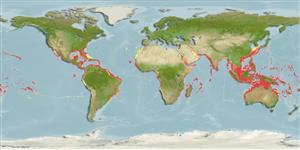Common names from other countries
>
Eupercaria/misc (Various families in series Eupercaria) >
Priacanthidae (Bigeyes or catalufas)
Etymology: Heteropriacanthus: Greek, heteros = other + Greek, prion = saw + greek, akantha = thorn (Ref. 45335).
More on author: Lacepède.
Environment: milieu / climate zone / depth range / distribution range
Ecologie
marien rifbewoner; diepte 3 - 300 m (Ref. 27000), usually 3 - 35 m (Ref. 40849). Subtropical; 33°N - 32°S, 180°W - 180°E
Atlantic and SW Indian Ocean: restricted. Former circumglobal distribution now accounted to former synonyms H. carolinus (widespread in the Indo-Pacific region) and H. fulgens (northeastern Atlantic Ocean).
Grootte / Gewicht / Leeftijd
Maturity: Lm ? range ? - ? cm
Max length : 50.7 cm TL mannelijk / geslacht onbekend; (Ref. 9990); common length : 20.0 cm SL mannelijk / geslacht onbekend; (Ref. 55763); max. gepubliceerd gewicht: 2.7 kg (Ref. 9990)
Dorsale stekels (totaal) : 10; Dorsale zachte stralen (totaal) : 12 - 13; Anale stekels: 3; Anale zachte stralen: 13 - 14. Silvery pink, mottled red or solid red in color; median fins with faint dark dots. Pelvic fins dusky or pale and without distinct spots (Ref. 4328). Section of preopercle behind canal striated and without scales (Ref. 26938).
Common in lagoon and seaward reefs, primarily around islands. Under or near ledges by day (Ref. 9710). Benthopelagic (Ref. 58302). Juvenile pelagic (Ref. 9335). Nocturnal (Ref. 5213), feeding mainly on octopi, pelagic shrimp, stomatopods, crabs, small fish, and polychaetes. Solitary (Ref. 5213). During the day usually occurs singly or in small groups but at dusk it may gather in large numbers (Ref. 37816). Known to produce sound. Marketed fresh (Ref. 3800). Minimum depth reported taken from Ref. 30874.
Levenscyclus en paargedrag
Maturities | Voortplanting | Spawnings | Egg(s) | Fecundities | Larven
Fernandez-Silva, I. and H.-C. Ho, 2017. Revision of the cicrumtropical glasseye fish Heteropriacanthus cruentatus (Perciformes: Priacanthidae), with resurrection of two species. Zootaxa 4273(3):341-361. (Ref. 115564)
Status op de Rode Lijst van het IUCN (Ref. 130435)
CITES (Ref. 128078)
Not Evaluated
Gevaar voor de mens
Reports of ciguatera poisoning (Ref. 30911)
Gebruik door de mens
Visserij: van minder commercieel belang; Aquarium: Commercieel
Tools
Speciale rapporten
Download XML
Internetbronnen
Estimates based on models
Preferred temperature (Ref.
115969): 23.3 - 29, mean 27.4 (based on 2452 cells).
Fylogenetische diversiteitsindex (Ref.
82804): PD
50 = 1.0000 [Uniqueness, from 0.5 = low to 2.0 = high].
Bayesian length-weight: a=0.01622 (0.01014 - 0.02593), b=2.88 (2.75 - 3.01), in cm Total Length, based on LWR estimates for this species & (Sub)family-body (Ref.
93245).
Trofisch niveau (Ref.
69278): 3.6 ±0.2 se; based on diet studies.
Weerstandsvermogen (Ref.
120179): Gemiddeld, minimale populatieverdubbelingstijd 1,4-4,4 jaar (Preliminary K or Fecundity.).
Fishing Vulnerability (Ref.
59153): Moderate vulnerability (40 of 100).
